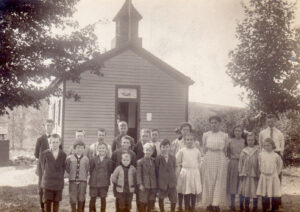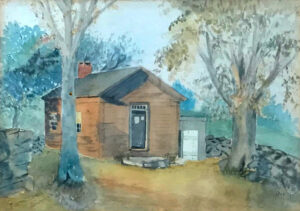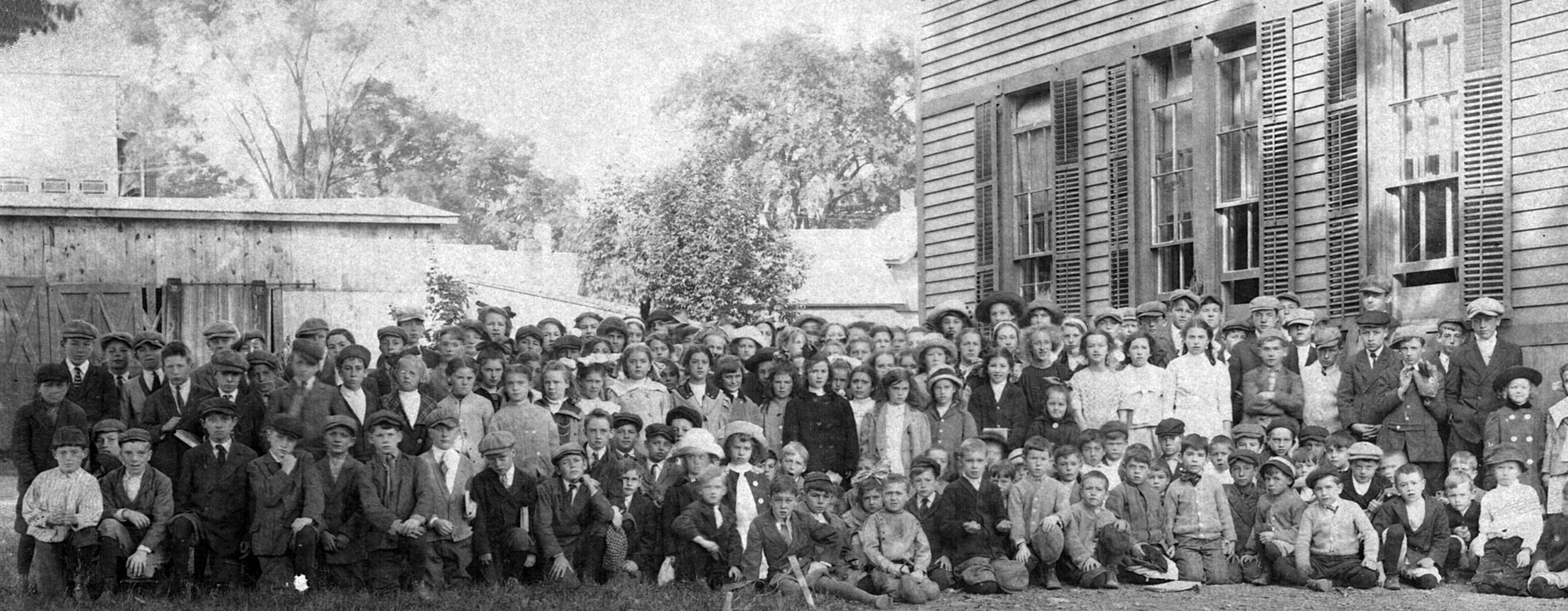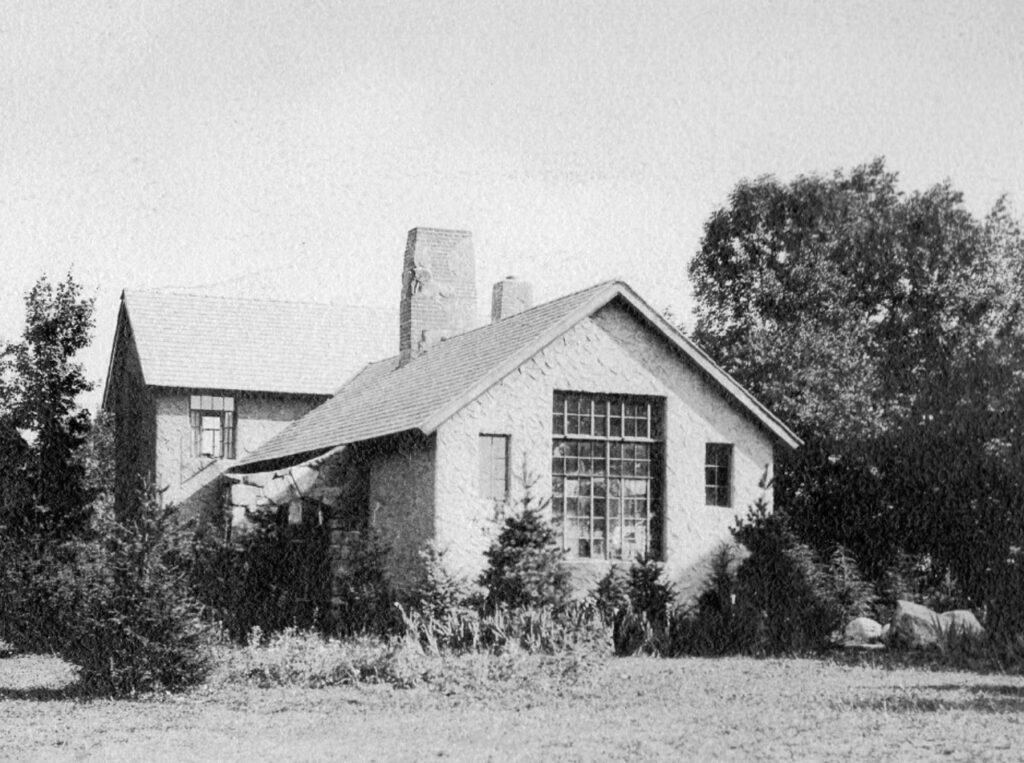 Students posed in 1910 in front of the Scotland schoolhouse. Closed in 1926, the building became a shed at the town poorhouse, but now is a small home.
Students posed in 1910 in front of the Scotland schoolhouse. Closed in 1926, the building became a shed at the town poorhouse, but now is a small home.Few institutions of America’s history have been as revered, romanticized, and fantasized as has “the little red schoolhouse.” Some historians say the old one-room schools instilled a solid education and good morals. Others maintain they were torture chambers that turned off countless youngsters on education.
For better or worse, Ridgefield was operating as many as 15 schoolhouses in the 1800’s. Seven of those still stand today.
Ridgefield’s first “school” was the unheated Meeting House, built around 1712, that was also the church and town hall. By 1721 the settlers spent eight pounds for a schoolhouse, probably with a fireplace, at Main Street and Branchville Road. As Ridgefield’s population increased, so did the need for schools. By the 1750s, schoolhouses existed in the Limestone, Ridgebury, Bennett’s Farm, Florida, and West Lane neighborhoods.
 Delia St. John, a teacher at the previous
Delia St. John, a teacher at the previous
Farmingville schoolhouse, painted her school in 1897.In 1767, Connecticut allowed towns to create “school district committees,” powerful mini-school boards that managed each schoolhouse and levied taxes to support them. However, committees worked under few rules and little oversight, resulting in schools of widely varying quality. Some committees hired teenage teachers with no training and little talent at the smallest salaries possible. While other committees sought out good teachers, even those usually had only an eighth-grade education. Despite this, they were put in charge of 30 or 40 kids, aged 4 to 16, enclosed in one room for six hours a day.
 143 pupils posed outside the Center School around 1913. The four-room building was seriously overcrowded — some children had classes in the town hall and the firehouse.
143 pupils posed outside the Center School around 1913. The four-room building was seriously overcrowded — some children had classes in the town hall and the firehouse.Reluctant spending was perhaps understandable; most parents were subsistence farmers, with little cash to give to the school tax collector. However, it could make student life miserable. Their schoolhouses were often poorly built and minimally maintained, leaky from above and drafty from below. Early seats were benches with no backs, and so high off the floor that younger children legs dangled uncomfortably. Fireplaces or stoves would overheat nearby children and leave those farther away shivering. Lighting was poor on cloudy days and too bright on sunny ones. Before 1850, many schools even lacked an outhouse!
Add to this the not-uncommon possibility of having a teacher who was downright incompetent, and unable to maintain order, much less teach. Worse, some were borderline sadists, happy to whip a child for the slightest infraction.
 the Whipstick School, became the wing of a house in 1915. From 1932 to 1942, it was the home and studio of painter Charles Sheeler.
the Whipstick School, became the wing of a house in 1915. From 1932 to 1942, it was the home and studio of painter Charles Sheeler.Despite many shortcomings, these “shacks” helped produce citizens who turned a struggling new nation into a world leader in industry, finance, farming, education, and the arts. Ridgefield’s schools had their share of illustrious alumni including three Goodriches: Samuel (“Peter Parley”), author of over 150 books; Charles, whose American history textbook was standard classroom fare for decades; and Abigail, among the nation’s first female magazine editors and publishers. Other luminaries included Cyrus Northrop, pioneering president of the University of Minnesota; Phineas and George Lounsbury, Connecticut governors; Frederic Fayerweather, a Tiffany designer; and U.S. congressman Jeremiah Donovan.
Four were alumni of West Lane, often called “the Peter Parley Schoolhouse” or “the Little Red Schoolhouse,” at West Lane and South Salem Roads. West Lane School closed in 1915 when several schools consolidated into Benjamin Franklin Grammar School on East Ridge (now the Venus Office Building). The Ridgefield Garden Club took over the schoolhouse, eventually turning it into a museum of early education. Today, the Ridgefield Historical Society operates the museum, open the last Sunday of the month May through October.
Five other schoolhouses exist with their former role largely hidden. Closed in 1925, Limestone School is now a house at 411 Danbury Road, just north of Limestone Service Station.
West Mountain, shuttered in 1929, became a laundry on a big estate, but was eventually converted into a house at 155 West Mountain Road.
Also residentially re-purposed, South Ridgebury School originally stood on Ridgebury Road just south of Ned’s Mountain Road but was moved southerly and opposite Old Stagecoach Road. Although it’s the smallest house in the neighborhood, it may have the
best view.
Shut down in 1926, Scotland School was hauled a mile south and turned into the little yellow house at 335 North Salem Road by alumnus Doug Main. Scotland’s bell, mounted atop a post, is displayed nearby.
A mile farther south is the Titicus schoolhouse at 71 North Salem Road, which still used outhouses when it closed in 1939. Initially a one-room school, Titicus got a second room around 1891 and a third in 1926. It’s now the American Legion post.
Farmingville schoolhouse, last used in 1937, was sold 15 years later to noted photographer Alexander Alland to use as his studio. Alland had it trucked to his North Salem, N.Y. house, where it stands today.
Whipstick schoolhouse at Whipstick and Nod Roads, closed in 1915, became part of a house where famous American artist Charles Sheeler lived and worked. Museums today display paintings he created there. Tragically, the house was destroyed in 2001 to make way for a “mini-mansion.”
Center School, serving the core of the village, went through many buildings and locations. The last — four-rooms in two stories built in 1884 on Bailey Avenue — became the town’s first high school in 1915. In 1926, it reverted to a primary school after the high school moved to East Ridge. It remained a primary school until 1955 when Veterans Park replaced it. Its site is now a parking lot.
Also gone are Bell School — the only schoolhouse with a bell in the 1840s — on lower Main Street, a victim of arson; Florida at Florida Hill and Florida Roads, a rare brick schoolhouse; short-lived North Ridgebury; Bennett’s Farm; and Flat Rock, which may still exist as a farm outbuilding-turned house on St. Johns Road.
Which leaves the 1870s Branchville school on Old Branchville Road, empty since 1939. The decaying landmark is still owned by the town. At this writing, the historical society hoped to assume its management, but it was unclear just how the building would be used and how much its preservation would cost.
Jack Sanders is the author of a dozen books focusing on Ridgefield history, including “School Days,” which describes early schools and schooling in Ridgefield.